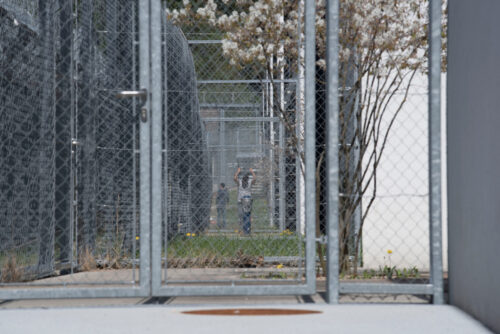On any given day, U.S. Immigration and Customs Enforcement (ICE) detains tens of thousands of individuals who are accused of violating U.S. immigration laws. ICE currently relies on a complex network of jails and jail-like facilities to confine these individuals.
The average daily population of immigrant detainees has increased more than fivefold in the past two decades. At the same time, immigration detention facilities have faced numerous civil and human rights violation complaints, including allegations of substandard medical care, sexual and physical abuse, and exploitative labor practices. Yet, the current administration has sought to further expand immigration detention. To assess the full implications of these expansion efforts, it is critical for policymakers and the public to understand fundamental aspects of the current U.S. detention system.
This report presents findings from an empirical analysis of immigration detention across the United States. We analyze government and other data on all individuals who were detained by ICE during fiscal year 2015, the latest fiscal year for which the federal government has released comprehensive data of this kind on immigration detention. Our analysis offers a detailed look at whom ICE detained, where they were confined, and the outcomes of their detention.
We find that ICE relied on over 630 sites scattered throughout the United States to detain individuals, often moving them from one facility to another. Our analysis reveals that individuals detained by ICE were commonly held in privately operated and remotely located facilities, far away from basic community support structures and legal advocacy networks.
The main findings presented in this report include:
A majority of detainees were men, from Mexico or Central America, and many detainees were juveniles.
- About 79 percent of the detainees were men. The population as a whole was relatively young, with the average age of 28 (mean and median). Over 59,000 detainees—about 17 percent—were under the age of 18.
- Mexican nationals by themselves made up about 43 percent of the detainee population, and individuals from the Northern Triangle region of El Salvador, Guatemala, and Honduras made up about 46 percent of the detainee population.
ICE used one or more facilities in every state, with Texas and California having the highest number of facilities and detainees.
- Every state in the United States had at least one facility that ICE used to detain individuals in fiscal year 2015.
- The top five states in terms of the number of facilities used by ICE in fiscal year 2015 were Texas, California, Florida, New York, and Arizona. The top five states in terms of the detainee population were Texas, California, Arizona, Louisiana, and New Mexico.
Detention in privately operated facilities and in remotely located facilities was common.
- Many detainees were confined in more than one facility during their detention stay. About 67 percent of all detainees were confined at least once in privately operated facilities. About 64 percent of detainees were confined at least once in a facility located outside of a major urban area.
- About 48 percent, 26 percent, and 22 percent of detainees were confined at least once in a facility that was located more than 60 miles, 90 miles, and 120 miles away, respectively, from the nearest nonprofit immigration attorney who practiced removal defense.
A majority of adult detainees experienced interfacility transfers involving movements across different cities, states, or federal judicial circuits.
- Many adults were transferred between facilities during their detention, leading to confinement in multiple locations. About 60 percent of adults who were detained in fiscal year 2015 experienced at least one interfacility transfer during their detention.
- Of those adults who were transferred, about 86 percent experienced at least one intercity transfer, 37 percent experienced at least one interstate transfer, and 29 percent experienced at least one transfer across different federal judicial circuits.
Detention length was significantly longer in privately operated facilities and in remotely located facilities.
- Among 261,020 adults who were released from detention during fiscal year 2015, the average detention length (mean) was about 38 days. More than 87,000 of these adults were detained longer than 30 days.
- Confinement in privately operated facilities and facilities located outside of major urban areas, respectively, was associated with significantly longer detention.
The number of grievances was significantly higher in privately operated facilities and in remotely located facilities.
- In fiscal year 2015, the ICE Enforcement and Removal Operations’ Detention Reporting and Information Line (DRIL) received over 48,800 detention-facility related grievances from detainees and community members. The most common type of grievances involved access to legal counsel and basic immigration case information.
- Privately operated facilities and facilities located outside of major urban areas were associated with higher numbers of grievances.
About the Data
We analyze three major datasets in this study. The first dataset—the Detention Data—contains government records pertaining to all individuals who were detained by ICE during fiscal year 2015 (355,729 individuals, including juveniles). To be included in the Detention Data, the individual had to have been detained at some point during fiscal year 2015, but his or her detention need not have begun nor ended in fiscal year 2015. The Transactional Records Access Clearinghouse (TRAC) obtained the Detention Data from ICE under the Freedom of Information Act (FOIA).
The second dataset consists of geocoordinates that we compiled on (1) all of the detention facilities included in the Detention Data, (2) the principal cities of metropolitan statistical areas (MSAs), and (3) legal service providers. We merged these geocoordinates with the Detention Data to produce the Geocoded Data that allows us to examine distances between detention facilities, MSAs, and legal service providers.
The third dataset contains records on 48,849 facility-related grievances submitted by detainees and community members to the Detention Reporting and Information Line. We merged these records with the Detention Data to produce the Grievance Data, which contains 47,145 grievances pertaining to 304 facilities used by ICE in fiscal year 2015 (including juvenile facilities used by ICE). Human Rights Watch obtained the Grievance Data from ICE through FOIA.
Immigration detention refers to the U.S. federal government’s practice of confining individuals accused of immigration law violations. Criminal incarceration, on the other hand, allows state or federal governments to confine individuals charged with, or convicted of, a criminal offense. Immigration detention occurs in a range of facilities and may last the duration of an individual’s immigration proceedings and, in certain situations, even after his or her immigration proceedings are completed.
Immigration detention is civil confinement that implicates core due process issues.
The law considers immigration detention to be strictly civil—that is, “nonpunitive and merely preventative” in nature. Accordingly, the U.S. government does not grant immigrant detainees the same set of legal protections that are afforded to criminal defendants, such as the right to government-appointed counsel, the privilege against self-incrimination, the ban on cruel and unusual punishment, and the right to a speedy trial.
Yet many aspects of immigration detention make detention indistinguishable from criminal incarceration. Immigrant detainees are typically held in jails and jail-like facilities. Detainees must wear government-issued uniforms and wristbands with identifying information at all times. Their daily lives are regimented, and they face constant surveillance. Moreover, the detainees can be subjected to discipline and segregation, and their contacts with the outside world are limited.
There are growing reports of civil and human rights violations in detention, including substandard medical care, sexual and physical abuse, and exploitative labor practices. ICE acknowledged at least 185 deaths in detention between October 2003 and July 2018. According to a report written by the Office of the Inspector General at the Department of Homeland Security (DHS) in December of 2017: “Overall, the problems we identified undermine the protection of detainees’ rights, their humane treatment, and the provision of a safe and healthy environment.” These problems ranged from the use of strip searches to the misuse of segregation.
The average daily detained population increased more than fivefold between 1994 and 2017.
The modern era of immigration detention in the United States began with the enactment of two laws in 1996: The Antiterrorism and Effective Death Penalty Act and the Illegal Immigration Reform and Immigrant Responsibility Act. These laws broadened the type of criminal offenses that could trigger removal proceedings. Both sets of laws also expanded the categories of noncitizens who could be detained without the possibility of release pending the completion of their removal proceedings.
Figure 1. Average Daily Detained Population, Fiscal Years 1994-2017
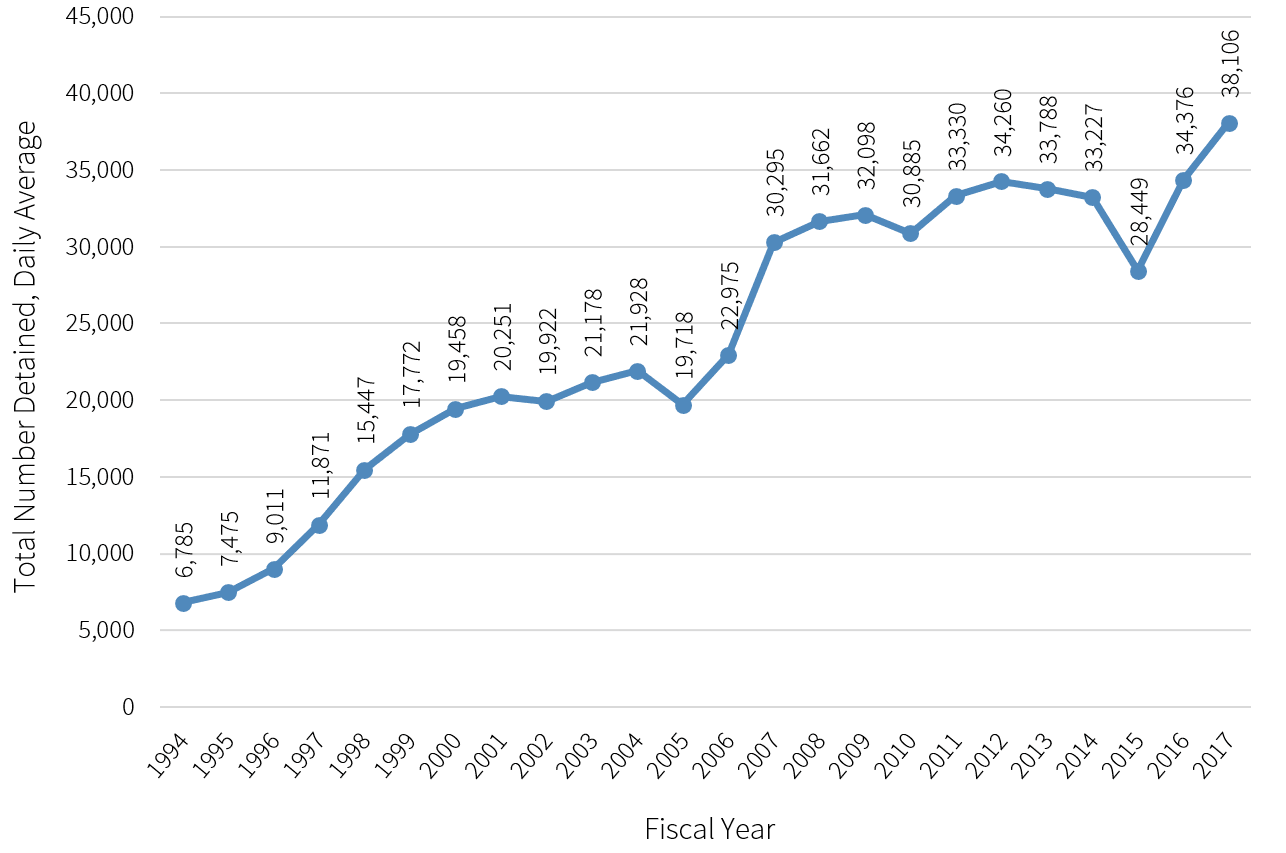
Source: For 1994-2000 statistics, see Alison Siskin, Congressional Research Serv., Immigration-Related Detention: Current Legislative Issues 11-12 (2004), https://perma.cc/2VSR-BFQ5. For 2001-2015 statistics, see U.S. Immigration & Customs Enf’t, Weekly Departures and Detention Report 9 (2016), https://perma.cc/5K8K-MVJ6. For 2016-2017 statistics, see U.S. Dep’t of Homeland Sec. & U.S. Immigration & Customs Enf’t, Budget Overview, Fiscal Year 2019 Congressional Justification 5 (2018), https://perma.cc/4P37-NCUG.
Since 1996, the number of noncitizens detained by immigration authorities rose steadily and dramatically. As Figure 1 shows, on any given day in fiscal year 1994, the federal government detained an average of 6,785 noncitizens. Twenty years later, that daily average surpassed 33,200. By fiscal year 2017, the average daily population of detainees stood at over 38,100. This represents a more than fivefold increase between 1994 and 2017.
Maintaining this system of confinement is costly. DHS’s budget for fiscal year 2017 estimated an average rate of $126.46 per day for adult detention beds, and an average rate of $161.36 per day for family detention beds. In total, the estimated cost of all detention beds amounted to over $1.4 billion in fiscal year 2017. This amount does not take into account millions of additional dollars needed to transport the detainees.
Detention has become a key enforcement strategy.
In 2014, the Obama administration set out enforcement priorities that focused on the removal of serious criminal offenders and recent border crossers. Notably, the average daily population of immigrant detainees dipped between fiscal years 2014 and 2015, as arrests and removals declined. Since 2015, however, the detained population has been rising again. Most recently, the Trump administration sought to target virtually all unauthorized immigrants regardless of whether they were ever convicted of a crime. This policy shift resulted in the increased removal rates of noncitizens without criminal convictions and the expanded use of detention as an essential immigration enforcement strategy.
According to the latest government statistics, the number of people booked into ICE custody through its interior enforcement program has increased steeply under the Trump administration. The President’s fiscal year 2019 budget request included funding to support 52,000 detention beds. To understand the implications of this expansion in detention, we need to understand the basic detention system that has been in place. The rest of this report describes the major findings from our empirical analysis of ICE detention during fiscal year 2015.
To understand whom ICE detained, we examined basic characteristics of the detainees such as gender, region of origin based on the country of citizenship, age at the time of first entry into ICE detention, legal status at the time of last entry into the United States (entry status), and whether or not they had been classified as an aggravated felon by ICE. Here, we focus on the following basic characteristics: gender, region of origin, and age.
To better understand the basic properties of all facilities used by ICE in fiscal year 2015, we examined the following key detention facility characteristics: (1) whether a given facility was operated by a for-profit company (Privately Operated), (2) whether a given facility was located outside of a major urban area (Outside MSA, as we describe in “Defining Facility Characteristics” below), and (3) distance to the nearest nonprofit immigration attorney who practice removal defense.
A majority of detainees were men, from Mexico or Central America, and about 17 percent of them were under the age of 18.
First, the detained population was heavily male—about 79 percent were men. Second, as shown in Figure 2, most detainees were from Mexico (43 percent) or the Northern Triangle region of Central America—El Salvador, Guatemala, and Honduras (46 percent). Together, these four countries constituted about 89 percent of the detainee population. The U.S. deportation regime has been called a “gendered racial removal program” that targets Latino men. Our findings call for systematic investigations into whether and how detention practices in particular might contribute to that dynamic.
Figure 2: Region of Origin of Detainees, Fiscal Year 2015
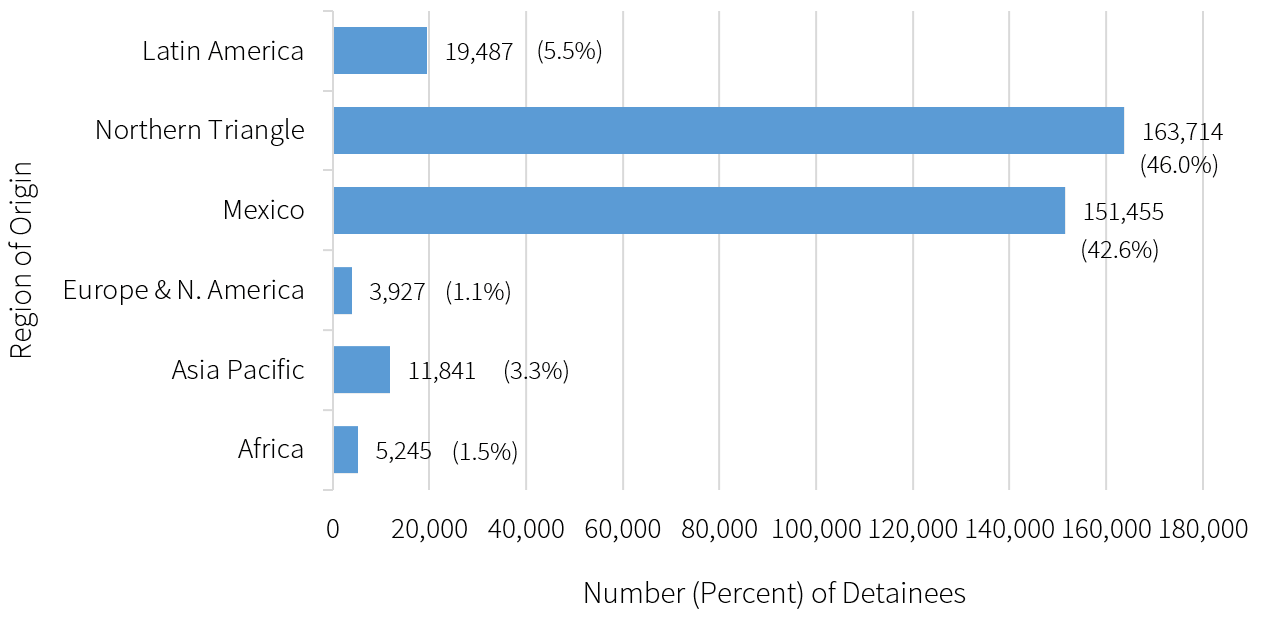
Source: Authors’ original analysis of the Detention Data.
The population as a whole was relatively young, with an average age of 28 (mean and median). As shown in Figure 3, over 59,00 detainees—about 17 percent of the detainees—were under the age of 18. Adults between the ages 18 to 30 made up the largest segment of the population (42 percent), followed by adults between the ages 31 to 40 (26 percent).
Figure 3. Age at Entry into Detention, Fiscal Year 2015
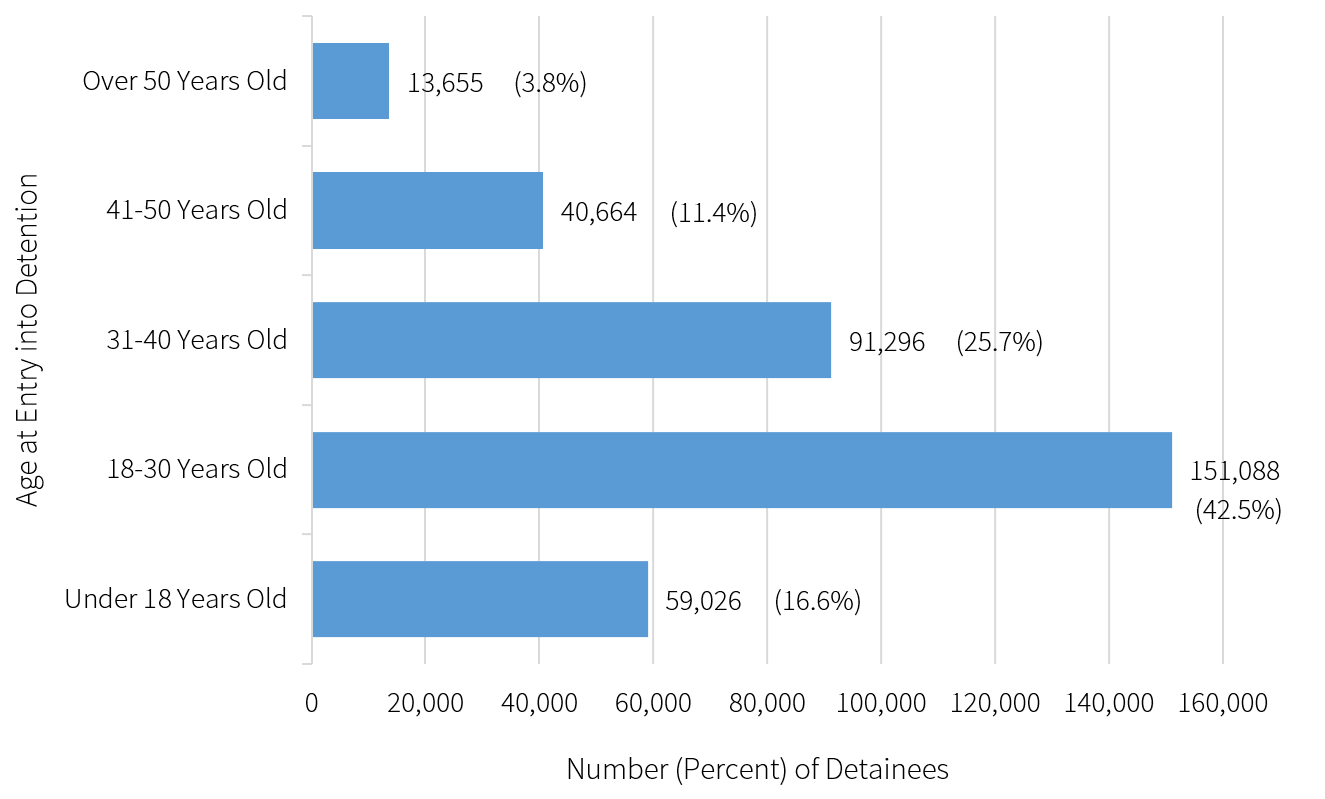
Source: Authors’ original analysis of the Detention Data.
Defining Detention Facilities
ICE uses the term “facility” in the Detention Data to refer to a range of locations that ICE used to detain individuals. Applying TRAC’s coding of detention facility types, we found that ICE used all of the following types of detention facilities during fiscal year 2015: (1) contract detention facilities, (2) holding/staging facilities, (3) ICE service processing centers, (4) facilities under intergovernmental service agreements with the federal government, (5) juvenile facilities, and (6) other facilities such as Federal Bureau of Prisons facilities, medical facilities, U.S. Marshals Service facilities, and motels or hotels.
The list of facilities that we analyze in this report is much broader than other lists of facilities that ICE has released in the past. This is because the other released lists include only those facilities that are authorized by the Detention Management Control Program (DMCP) and subject to DMCP inspections. The list of DMCP authorized facilities excludes many other facilities used by ICE for detention, such as temporary holding and/or processing facilities, Bureau of Prisons facilities, family or residential facilities, juvenile facilities, hospitals, hotels or motels, and short-term facilities.
All states had one or more facilities that ICE used to detain individuals, with Texas and California having the highest number of facilities and detainees.
In fiscal year 2015, ICE used 638 facilities to detain noncitizens, including juveniles. By far, the largest category—43 percent—were facilities with intergovernmental service agreements (IGSAs). IGSAs are agreements between the federal government and a state or local government to provide detention beds in jails, prisons, and other local or state government detention facilities. These facilities are government owned, but they may be operated by either local or state agencies or by for-profit companies.
As shown in Figure 4, every state in the United States had at least one immigration detention facility in FY 2015. Most of the facilities were located either in the South (39 percent) or the West (30 percent), followed by the Midwest (15 percent) and the Northeast (14 percent). The top five states in terms of the total number of facilities were: Texas (115 facilities), California (70 facilities), Florida (43 facilities), New York (39 facilities), and Arizona (33 facilities).
Figure 4. Number of Detention Facilities Used by ICE, Fiscal Year 2015
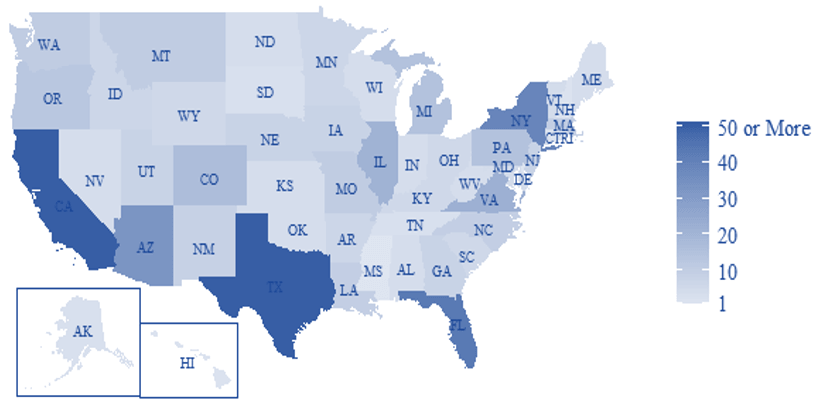
Note: U.S. territories of Guam, Puerto Rico, the Northern Mariana Islands, and the Virgin Islands are not shown, but each territory had at least one detention facility.
Source: Authors’ original analysis of the Geocoded Data.
Table 1 shows the top 15 states in terms of the total number of individuals detained in fiscal year 2015. By far, Texas had the highest number of detainees, followed by California, then Arizona. Interestingly, Arizona, Louisiana, and New Mexico had some of the highest levels of detainee populations in fiscal year 2015, yet they maintained relatively few facilities compared to Texas and California. Drilling down further to understand which counties and cities are likely to hold immigrant detainees will help us to better understand how federal-local partnerships in immigration enforcement might be shaping spatial patterns of immigration detention.
Table 1. Top 15 States by Detainee Population, Fiscal Year 2015
|
Rank |
State |
Percent of Total Detainee Population |
Total Number Detained |
|---|---|---|---|
|
1 |
Texas |
43.6 % |
192,771 |
|
2 |
California |
11.6 |
51,162 |
|
3 |
Arizona |
10.0 |
44,283 |
|
4 |
Louisiana |
6.0 |
26,481 |
|
5 |
New Mexico |
4.5 |
19,927 |
|
6 |
Georgia |
2.9 |
12,736 |
|
7 |
Florida |
2.6 |
11,310 |
|
8 |
New York |
1.9 |
8,374 |
|
9 |
New Jersey |
1.5 |
6,772 |
|
10 |
Illinois |
1.5 |
6,765 |
|
11 |
Pennsylvania |
1.5 |
6,543 |
|
12 |
Washington |
1.4 |
6,356 |
|
13 |
Virginia |
1.0 |
4,460 |
|
14 |
Colorado |
0.8 |
3,682 |
|
15 |
South Carolina |
0.8 |
3,603 |
Source: Authors’ original analysis of the Detention Data.
Defining Facility Characteristics
Facilities are coded as privately operated if they were operated by non-governmental, for-profit correctional companies, such as the GEO Group, CoreCivic, and MTC Corrections. Publicly-owned facilities, such as county jails, may be privately operated.
Detention facilities located outside of the principal (largest) cities of metropolitan statistical areas (MSAs) are treated as placed outside of major urban areas. The U.S. Office of Management and Budget defines an MSA as consisting of “at least one urbanized area that has a population of at least 50,000.”
Each facility’s distance to the nearest nonprofit immigration attorney is measured by driving distance to the nearest immigration attorney who was an active member of the American Immigration Lawyers Association (AILA) in fiscal year 2015. Specifically, we focus on AILA attorneys who practice removal defense at legal services/nonprofit organizations or law schools.
This report provides portraits of detention facilities both at the facility level and at the detainee level. The estimates at the facility level indicate the percentage of facilities falling within a given category (for example, Privately Operated). The estimates at the detainee level indicate the percentage of detainees who were confined at least once in a facility falling within a given category. Detainee level analysis is different than the facility level analysis because some detainees moved in and out of various facilities during their detention due to interfacility transfers.
Detention in privately operated facilities and in remotely located facilities was common.
According to a recent government report, 65 percent of the average daily detainee population as of September 2016 was confined in facilities operated by private, for-profit contractors. The expanding role of for-profit companies in the U.S. detention system has become a focal point of growing concern among advocates, scholars, and policymakers. Chief among these concerns is that certain issues may be considerably magnified in privately operated facilities, including a lack of transparency and accountability and substandard or dangerous conditions of confinement.
Figure 5 shows that while for-profit companies operated only about 10 percent of the facilities, about 67 percent of individuals (including juveniles) were detained at least once in a privately operated facility. This is attributable to the relatively large capacity of privately operated facilities. For example, during fiscal year 2015, non-privately operated facilities each held on average 500 detainees, whereas privately operated facilities each held on average 5,581 detainees.
Another prominent feature of the current U.S. detention system relates to the location—or more precisely, the relative remoteness—of many of the detention facilities. Remoteness is of concern because confinement in remote locations that are outside of and distant from urban areas can separate detainees from their families, and community and legal support networks that may be critical to their well-being and chances of achieving favorable case outcomes. Figure 6 shows that about 50 percent of all facilities were located outside of major urban areas, and about 64 percent of all individuals (including juveniles) were detained at least once in facilities located outside of major urban areas.
Figure 6. Location of Facilities Used by ICE, Fiscal Year 2015
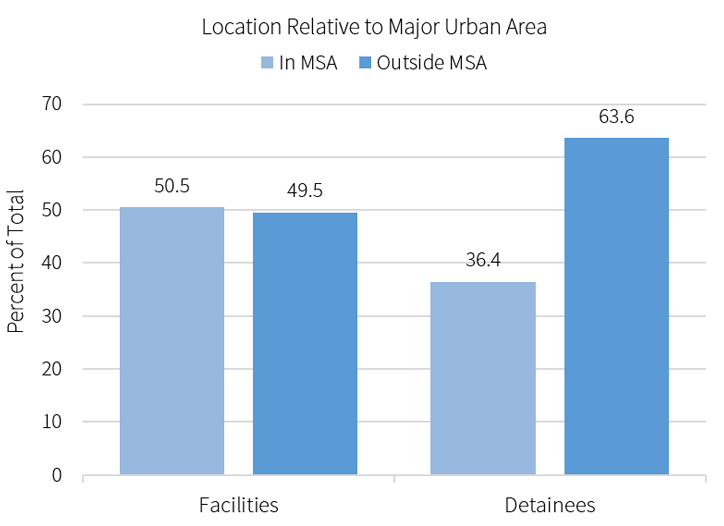
Note: A metropolitan statistical area (MSA) is an urbanized area that has a population of at least 50,000. We treat detention facilities located outside of the largest cities of MSAs as outside of major urban areas (Outside MSA).
Source: Authors’ original analysis of Geocoded Data.
In addition, we found that about 58 percent of individuals were detained at least once in a facility that was more than 30 miles away (in terms of driving distance) from the nearest nonprofit immigration attorney who practiced removal defense. A large proportion of detainees were confined in facilities that were even further away. For example, about 48 percent, 26 percent, and 22 percent of detainees were confined at least once in a facility that was located more than 60 miles, 90 miles, and 120 miles away, respectively, from the nearest nonprofit immigration attorney who practiced removal defense. Taken together, these results indicate that many detainees were held in locations that were relatively far from basic community structures and legal-services networks.
To understand what happened to individuals once detained, we examined the following key detention outcomes: the number and type of transfers between facilities during detention, detention length, and the number and type of facility-related grievances. Our detention outcome analysis primarily focuses on adult detainees (N=296,703) given that a different set of legal requirements applies for the detention of juveniles.
Defining Transfers
For each detainee in the Detention Data, ICE generated a new detention record each time the individual was booked into a facility. In addition, ICE assigned each such record a release reason to indicate what had happened to the detainee at the end of the detention stint corresponding to each book-in. We treat a movement as a transfer if a given record has the release reason of “transferred” or “U.S. Marshals or other agency.”
We refer to these movements as interfacility transfers for the following reason: each facility in the Detention Data has a code assigned by ICE that is supposed to uniquely identify each facility. During our data cleaning, we ensured that for any given detainee with multiple detention records, each of his or her consecutive detention records had different facility codes. In effect, all of the transfers that we analyze in this study involved movements from one location to another location with distinct facility codes.
A majority of adult detainees experienced transfers, many of which involved movement across different cities, states, or federal judicial circuits.
The government has interpreted the law as providing the Attorney General broad discretion to transfer detainees. Accordingly, ICE has detained individuals where they were first taken into custody or transferred them to remote and distant facilities, including ones that are outside the jurisdiction of the presiding immigration court.
Transfers during detention can negatively impact detainees and their legal cases in a number of ways. For example, transfers may sever the detainees’ familial and social contacts, disrupt the continuity of their medical care and legal representation, and interfere with their efforts to navigate the legal system more generally.
Figure 7 shows that among all adults who were released during fiscal year 2015 (261,020 individuals), 70,254 detainees (27 percent) experienced one transfer before their release, 39,296 detainees (15 percent) experienced two transfers before their release, and 32,577 detainees (12 percent) experienced three or more transfers before their release. In all, about 54 percent of released individuals experienced at least one transfer during their detention.
Figure 7. Number of Detention Facility Transfers among Adults Released in Fiscal Year 2015
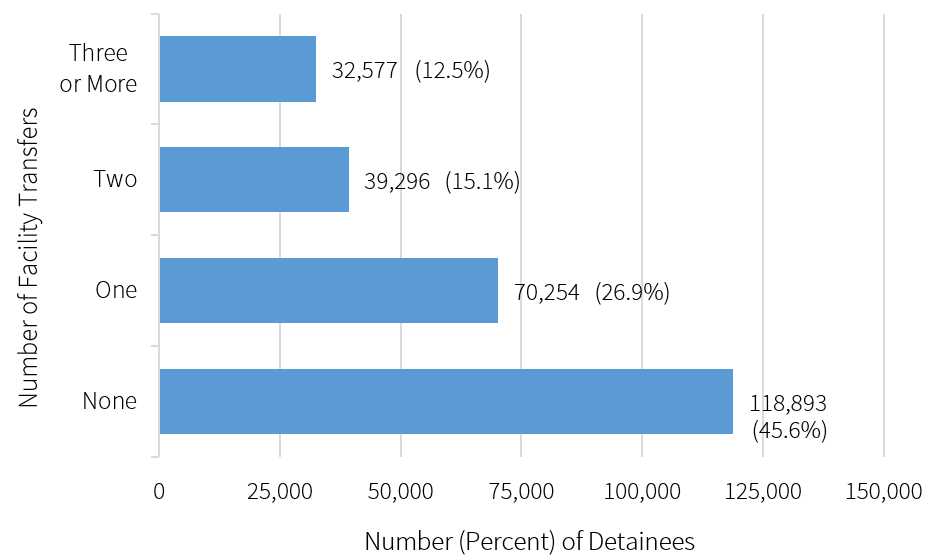
Source: Authors’ original analysis of Detention Data.
It is also helpful to consider the types of transfers that the detainees experienced, because different types of transfers may impose different types of challenges for the detainees, as we discuss below. We coded the transfers into three broad categories: intercity, interstate, and intercircuit. Intercity transfers are transfers between detention facilities that are located in two different cities (within the same state or across different states). To understand the extent to which these intercity transfers involved movements across different states, we also examined interstate transfers, which refer to transfers between two different states. Intercircuit transfers refer to transfers between two different federal judicial circuits, including the D.C. circuit.
Intercircuit transfers are of special concern, as such transfers can result in changes in the law governing the detainees’ immigration cases. In some instances, an intercircuit transfer can dramatically alter the outcome of a case and increase the likelihood of deportation without due process, because some federal district courts are less willing to issue a stay of deportation while the case is being appealed.
Table 2 shows that 177,402 out of 296,703 adults who were detained by ICE in fiscal year 2015 (60 percent) experienced at least one transfer. Among these 177,402 adults, about 86 percent experienced at least one intercity transfer, about 37 percent experienced at least one interstate transfer, and about 29 percent experienced at least one intercircuit transfer. Table 2 also shows that among 353,704 total transfers experienced by 177,402 adults, about 89 percent of the transfers were intercity transfers, about 28 percent were interstate transfers, and about 19 percent were intercircuit transfers.
Table 2. Type of Transfers for Detained Adults with at Least One Transfer, Fiscal Year 2015
|
Transfer Type |
Percent of Detainees |
Number of Detainees |
Percent of Transfers |
Number of Transfers |
|---|---|---|---|---|
|
Intercity |
85.8 % |
152,214 |
88.7 % |
313,813 |
|
Interstate |
36.9 |
65,500 |
27.7 |
97,887 |
|
Intercircuit |
29.2 |
51,850 |
19.4 |
68,601 |
|
Total |
|
177,402 |
|
353,704 |
Source: Authors’ original analysis of Detention Data and Geocoded Data.
Another way of examining the transfers is to consider the average distance (mean) involved in different types of transfers. Figure 8 shows that intercircuit transfers involved the longest distance, an average of about 820 miles. Intercity transfers involved the shortest driving distance, an average of about 297 miles. Across all types of transfers, the average distance traveled was about 270 miles.
Figure 8. Average Driving Distance of Transfers among Detained Adults, Fiscal Year 2015
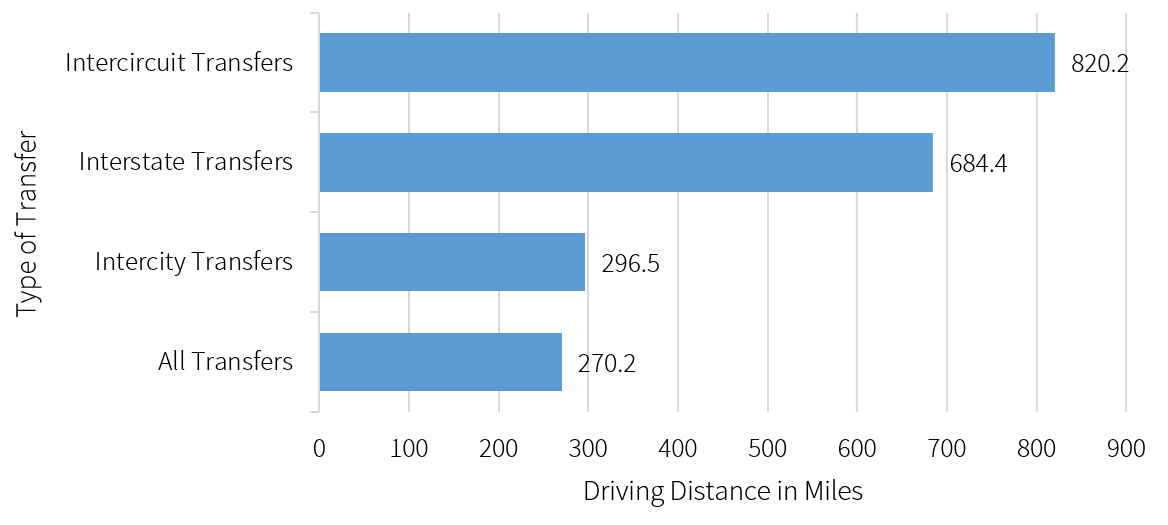
Source: Authors’ original analysis of Geocoded Data.
The policy directive issued by ICE in 2012 enumerates a series of officially-sanctioned reasons for transfers, including reasons related to “medical or mental health care to the detainee” and the “safety and security of the detainee, other detainees, detention personnel or any ICE employee.” Advocates and researchers, however, have reported a variety of other reasons for transfers, including retaliation against detainees for speaking up or organizing. To our knowledge, ICE does not maintain electronic records of why any given detainee is transferred, nor how ICE’s placement and transfer policies work in practice on the ground. Yet the basic patterns of transfers that we have described here underscore the critical need for the government to collect and to make publicly available precisely such information as a first step toward reducing transfers and mitigating their associated harms.
Defining Release from Detention
In examining detention length, we conducted separate analyses for the individuals who were removed, granted relief, or temporarily released. This subgroup analysis approach reduces the risk that our findings might be confounded by fundamental dissimilarities across individuals who experienced different types of releases.
The removed category includes individuals who were removed to their countries of origin. The granted relief category includes individuals whose recorded release reason was “Proceedings Terminated,” “Deferred Action for Childhood Arrivals,” “Deferred Action for Parents of Americans and Lawfully Admitted Residents,” or “Prosecutorial Discretion.” The granted relief category includes individuals who won their claims for relief from removal, such as asylum, adjustment of status, and cancellation of removal. The temporarily released category includes individuals whose recorded release reason was “Alternatives to Detention,” “Bonded Out,” “Order of Recognizance,” or “Order of Supervision.” In short, the temporarily released category includes individuals who were released so that they could await the completion of their removal proceedings on the outside.
Among adult detainees, detention length was significantly longer in privately operated facilities and in remotely located facilities.
The second key outcome we examine is detention length. Figure 9 shows that about 17 percent of adult detainees released in fiscal year 2015 were released on the same day as their initial book-in. But many—about one-third of the population—were detained for more than 30 days. The average length of detention (mean) was about 38 days. The longest detention length among adults who were released in fiscal year 2015 was 2,943 days, indicating that one person was detained for over eight years. This detainee was not alone in experiencing years of detention. For example, 1,800 adults who were released in fiscal year 2015 were detained between 1 to 2 years; another 273 adults were detained between 2-3 years, and 117 adults were detained more than 3 years, before being released in fiscal year 2015.
Figure 9. Total Days Detained among Adults Released in Fiscal Year 2015
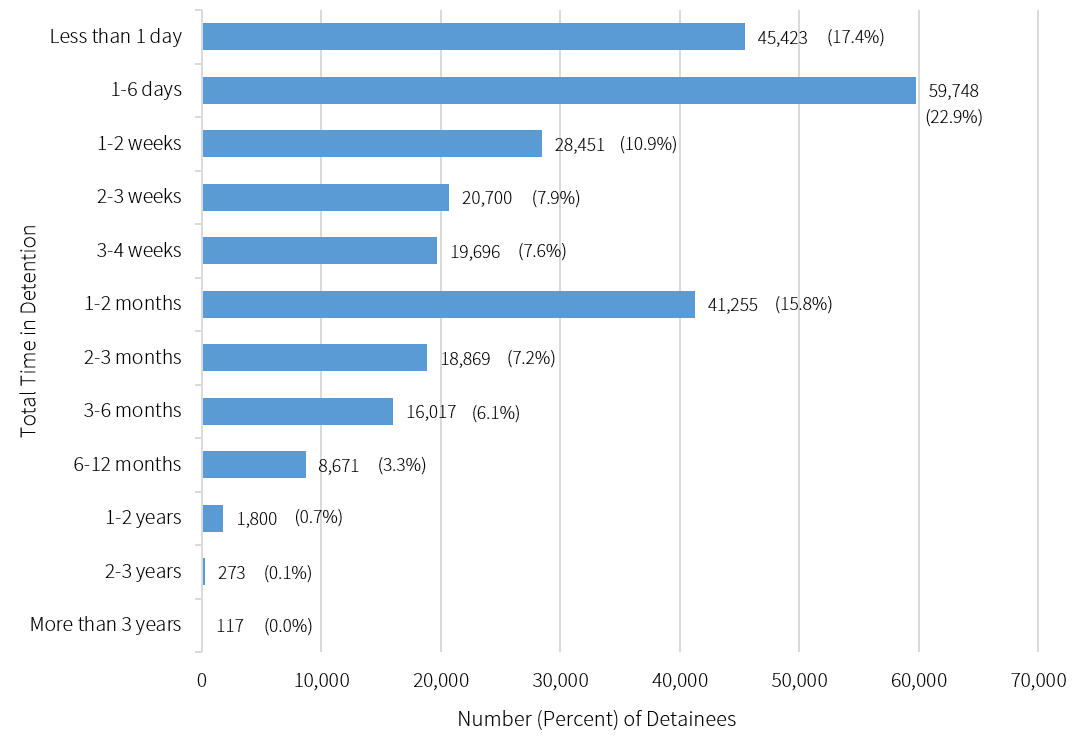
Source: Authors’ original analysis of Detention Data.
Did detention lengths vary by type of facility operators and facility locations? Figure 10 shows that across all major release categories, the average detention length was consistently and substantially longer in privately operated facilities than in non-privately operated facilities. Figure 11 shows that across all major release categories, the average detention length was consistently and substantially longer in facilities located outside of major urban areas compared to facilities located within major urban areas.
Figure 10. Average Days Detained among Adults by Type of Operation, Fiscal Year 2015

Source: Authors’ original analysis of Detention Data.
Figure 11. Average Days Detained among Adults by Facility Location, Fiscal Year 2015
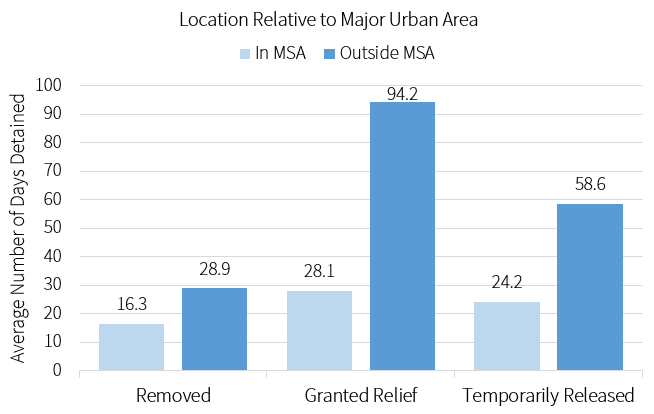
Note: A metropolitan statistical area (MSA) is an urbanized area that has a population of at least 50,000. We treat detention facilities located outside of the largest cities of MSAs as outside of major urban areas (Outside MSA).
Source: Authors’ original analysis of Detention Data.
We tested the robustness of these findings by analyzing detention length while controlling for a variety of individual and contextual factors, including gender, region of origin, age, legal status at the time of last U.S. entry, and criminal history, count of transfers, miles to nearest nonprofit immigration attorney, as well as the regional location of facilities. Our regression analysis results are consistent with the patterns presented in Figures 10 and 11. For example, among those who were removed, confinement in a privately operated facility was associated with an 82 percent increase in detention length. The same is true of confinement in facilities located outside of major urban areas, which was also associated with an 82 percent increase in detention length.
Why might detention length be longer in privately operated facilities and facilities located outside major urban areas? Data scarcity prevents us from empirically addressing this question. However, a number of potential explanations are worth considering. First, ICE may be systematically identifying and placing detainees who are likely to be detained longer into these types of facilities.
Second, privately operated facilities and facilities located outside of major urban areas tend to detain a substantially higher number of individuals on average. Geographical concentrations of large detainee populations are likely associated with longer court backlogs, and in turn, longer time to release, all else being equal.
Third, certain conditions of confinement in privately operated facilities and facilities located outside of major urban areas may be systematically linked to longer detention. For example, insofar as telephone calls are more expensive in privately operated facilities, or visitation is more difficult in facilities located outside of major urban areas, detainees may face greater challenges in obtaining legal counsel or obtaining materials necessary for their court hearings. If so, we might expect detainees in such facilities to seek court continuances at higher rates, leading to longer detention.
In sum, our findings raise important questions about whether certain structural conditions in privately operated facilities and in remotely located facilities may produce longer detention lengths.
The number of grievances was significantly higher in privately operated facilities and in remotely located facilities.
The conditions of confinement in detention have generated concern and litigation across many different facilities. Examining the types and prevalence of grievances that detainees and community members filed against detention facilities provides one insight into the conditions of confinement. The grievances that we examine here were captured through calls that the ICE Enforcement and Removal Operations’ Detention Reporting and Information Line (DRIL) received from detainees and community members in fiscal year 2015.
It is important to note that DRIL is only one mechanism through which detainees and community members can report grievances related to detention facilities. Nonetheless, the Grievance Data is an important source of information on grievances given that detainees may be more likely to be aware of its existence than other reporting mechanisms.
The original data relating to grievances that Human Rights Watch received from ICE contained a total of 48,849 grievances pertaining to specific detention facilities. Matching these facilities to the facilities in the Detention Data and restricting the sample to only those facilities used by ICE in fiscal year 2015 produced an analysis sample of 47,145 grievances pertaining to 304 facilities. We consolidated 18 different grievance categories as reported by ICE into seven broad grievance types, as shown in Table 3.
Table 3. Number and Types of Grievances, Fiscal Year 2015
|
Grievance Type |
Percent of Total Grievances |
Number of Grievances |
|---|---|---|
|
Access to Counsel/Case Information |
66.6 % |
31,417 |
|
Access to Outside/Family Separation |
12.5 |
5,892 |
|
Bond/Release from Facility |
7.9 |
3,741 |
|
Asylum Related |
4.8 |
2,241 |
|
Health/Medical Care Related |
1.6 |
772 |
|
ICE or Facility Misconduct/Abuse |
1.5 |
729 |
|
Other |
5.0 |
2,353 |
|
Total |
100 % |
47,145 |
Source: Authors’ original analysis of Grievance Data.
The majority of the grievances involved issues relating to access to legal counsel and basic immigration case information—a total of 31,417 grievances constituting 67 percent of all grievances. We also found a high prevalence of grievances relating to access to the outside and family separation issues. This grievance type includes the following categories of grievances as reported by ICE: “Online Detainee Locator, “Telephone Access,” “Visitation,” and “Separation from Minor Child or Other Dependent or Parental Related.”
Next, we examined whether the number of grievances varied by the type of facility operator and facility location. Figure 12 shows that a substantially higher number of grievances on average (mean) were filed against privately operated facilities and facilities located outside of major urban areas.
Figure 12. Average Number of Grievances by Type of Operation and Facility Location, Fiscal Year 2015
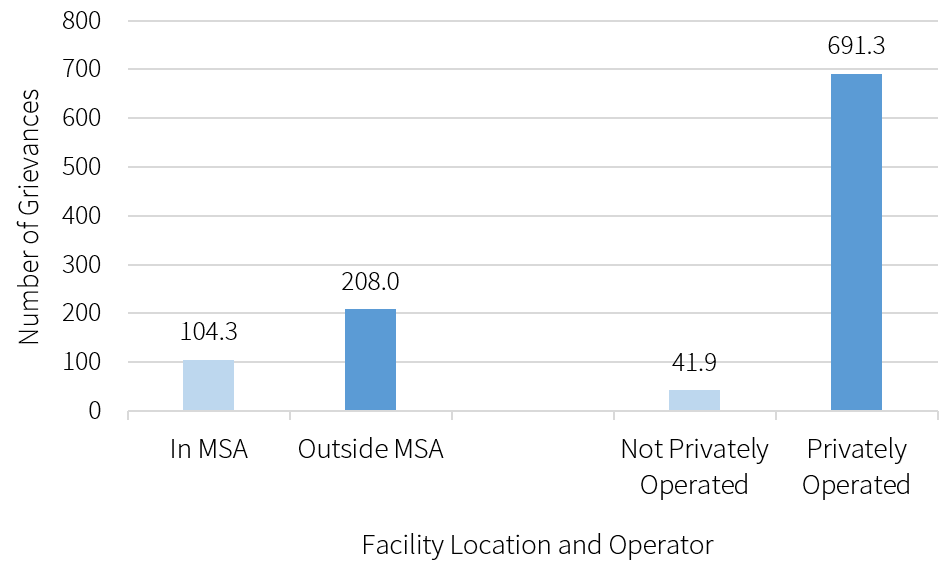
Note: A metropolitan statistical area (MSA) is an urbanized area that has a population of at least 50,000. We treat detention facilities located outside of the largest cities of MSAs as outside of major urban areas (Outside MSA).
Source: Authors’ original analysis of Grievance Data.
To assess the robustness of these results, we conducted a regression analysis of grievances that controls for other possible determinants of grievances. These control variables include (1) proportion male (the proportion of detainees confined in any given facility during fiscal year 2015 who were male); (2) proportion Mexican (the proportion of detainees confined in any given facility during fiscal year 2015 who were of Mexican origin); (3) total detainee population (the total number of detainees confined in a given facility during fiscal year 2015); (4) average detention length (the average number of days detained in any given facility in fiscal year 2015; and (5) whether or not the facility was a juvenile facility.
The results of this regression analysis are consistent with our findings shown in Figure 12. In short, we find that privately operated facilities are expected to have about 175 percent more grievances than non-privately operated facilities, controlling for the factors noted above. Facilities located outside of major urban areas are expected to have about 51 percent more grievances than facilities located inside major urban areas, all else being equal.
There is no evidence to suggest that it is easier to submit grievances in privately operated facilities and in remotely located facilities. On the contrary, existing research suggests that the opposite is likely true. For example, reports suggest that privately operated facilities are more likely to lack transparency and public accountability. It is also important to note that our findings are consistent with the findings resulting from investigations of correctional facilities in the criminal justice system. These investigations revealed that privately operated prisons had a worse record on most safety and security measures relative to comparable facilities operated by the Federal Bureau of Prisons.
This report’s findings highlight several key aspects of immigration detention that should be central to any current policy discussions about detention oversight and reform. These key aspects include: (1) the reasons for and the frequency of interfacility transfers, (2) the length of detention, and (3) the nature and volume of grievances filed against detention facilities.
As the federal government expands the use of detention in support of its strict enforcement regime, many of the issues that we have highlighted in this report may become magnified in scope and severity. For example, with the surge in immigration apprehensions under the current administration, there have been numerous reports of sudden, chaotic, and mass transfers of detainees across various facilities. These reports raise renewed concerns about ICE’s use of interfacility transfers and the serious challenges that these transfers raise for detainees in terms of their well-being and ability to pursue legal relief from removal.
Finally, our findings suggest that privately operated facilities and remotely located facilities require special scrutiny, given that placement in these types of facilities is associated with longer detention length and higher volume of grievances. Comprehensive investigations and independent monitoring focused on these types of outcomes and facilities are urgently needed to address the ongoing humanitarian issues and legal concerns raised by immigration detention.



